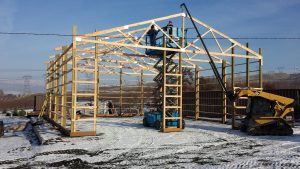In order to follow the deflection criteria of the International Building Codes, other than for fairly small wall column spacings with low wind speeds, pole building wall girts need to be installed in a “bookshelf” fashion.
What even is “deflection criteria”?
Dictionary.com defines deflection as, “the deviation of the indicator of an instrument from the position taken as zero.”
In layperson’s terms, when you push on something with a known force, how far does it bend (or deflect)?
 Prior to the adoption of the International Building Codes, wall members which did not support a brittle finish material (e.g. drywall), were not limited in how far they could deflect.
Prior to the adoption of the International Building Codes, wall members which did not support a brittle finish material (e.g. drywall), were not limited in how far they could deflect.
Not so with the new code.
For those of you who care to look it up and read along, Table 1604.3 lists deflection limits. For walls with brittle finishes, the limitation is L/240 (where “L” is the span or length of the supporting member). For flexible finishes, the limit is L/120. Footnote A includes, “For secondary wall members supporting formed metal siding, the design wind load deflection shall not exceed L/90.”
The smaller the value L is divided by, the larger the allowable deflection is.
Ignoring the width of nominal six inch building columns the allowable deflection of wall girts for an 8’ bay (with steel siding) would be 1”; a 10’ bay 1.27”; 12’ bay 1.54”.
Using the least possible loads allowed by code – which would be 85 mile per hour winds, B wind exposure and a building Occupancy class of I (I = a building which represents a low hazard to human life in the event of failure) combined with the stiffest possible commonly used lumber (Douglas Fir or Southern Yellow Pine #2) and spaced 24 inches on center, some problems occur.
Using 2×6 lumber on 10’ bays the actual deflection is 1.507” and on 12’ bays 3.226”. On 8’ bays IF 2×4 #2 is actually used (it is rarely available in lumber yards), then it would deflect 0.924” and be OK. Another issue with the 2×4 girts on 8’ bays, is this style of construction is most prevalent in areas where the minimum wind speed is 90 mph.
Keeping all variables the same, except increasing the wind speed to 90 mph, increases the deflection of a 2×4 #2 to over an inch on an eight foot bay!
Shopping for your new ideal dream pole building? If so, ask specifically how the wall girts are placed. Anything other than “bookshelf” style pretty much guarantees the building being proposed, is not code conforming!






